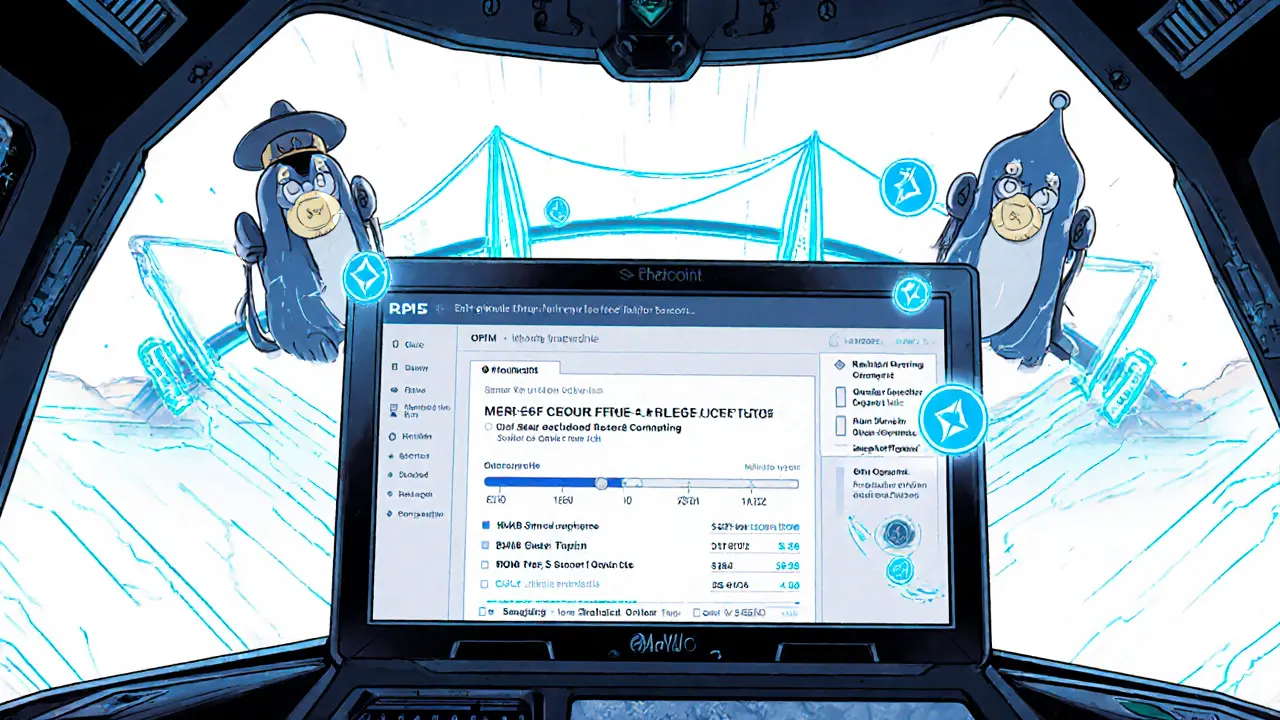Opium Network Review: Decentralized Derivatives Exchange in 2025

Opium Network Liquidation Risk Calculator
This calculator shows potential liquidation prices based on your input parameters. Actual liquidation prices on Opium Network may vary due to:
- Oracle price feed delays
- Gas fee fluctuations
- Market volatility
- Protocol-specific liquidation mechanisms
Calculate Your Liquidation Risk
Tip: Higher leverage increases liquidation risk. For Opium Network positions, maintain 2-3x more collateral than the minimum requirement to avoid liquidation during volatility.
Your Position Risk Analysis
Enter your position details above to see liquidation risk analysis.
When you type "Opium Network crypto exchange review" into Google, you probably expect a rundown of a typical spot‑trading platform. The reality is a bit different: Opium Network is a decentralized derivatives protocol, not a traditional exchange. This review breaks down what Opium actually does, how it compares to conventional exchanges, and whether it’s worth your time in 2025.
What is Opium Network?
Opium Network is a decentralized finance (DeFi) protocol that lets users create, settle, and trade derivatives without a central counterparty. Launched in 2019 by a Dutch team and reaching mainnet in Q42020, Opium positions itself as a "universal protocol for trustless derivatives" (Opium Finance, 2025). Its native token, OPIUM, provides governance rights and risk‑management utilities across the system.
The platform runs on multiple blockchains, most notably Ethereum, BNB Smart Chain, and Polygon, allowing cross‑chain futures, options, and perpetual swaps.
Core Features and How They Work
- Derivatives Marketplace: Users can mint custom contracts (e.g., ETH‑USD futures) and trade them directly from their Web3 wallet.
- Trustless Settlement: Smart contracts enforce settlement, eliminating the need for a custodian.
- Governance: OPIUM holders vote on protocol upgrades, fee parameters, and oracle selections.
- Cross‑Chain Compatibility: Integration with Chainlink (via CCIP in v3.0) ensures price feeds are available on all supported chains.
- Composability: The protocol can be layered with lending platforms like Aave for collateralized positions.
Getting Started: Step‑By‑Step
- Install a Web3 wallet (MetaMask, Trust Wallet, or any WalletConnect‑compatible app).
- Navigate to opium.finance and click "Connect Wallet".
- Approve the OPIUM token contract to allow the protocol to read your balance.
- Select a market (e.g., BTC‑USDT perpetual), set notional amount, leverage, and collateral type.
- Confirm the transaction; gas fees are paid in the underlying blockchain's native token (ETH, BNB, etc.).
- Monitor your position via the "Risk Dashboard" (GitHub community tool) for price‑feed health and liquidation risk.
The whole flow takes about 20‑30minutes for an experienced DeFi user, but newcomers often need extra guidance.
Pros and Cons
| Aspect | Pros | Cons |
|---|---|---|
| Decentralization | Non‑custodial, no counterparty risk | Relies on oracles, vulnerable during market stress |
| Liquidity | Institution‑grade risk parameters attract professional traders | Low TVL ($8.7M in 2024) limits retail depth |
| User Experience | API support, integrates with 12+ wallets | Complex UI, steep learning curve for non‑developers |
| Fees | No protocol‑level trading fee; only gas costs | Gas spikes on Ethereum can make small trades uneconomic |
| Security | Certified 92/100 by CertiK (v2.1) | Liquidation engine price‑feed aggregation flagged as critical risk |

Security Audits and Risks
Opium’s most recent audit (CertiK, March2025) awarded a 92/100 score, praising its smart‑contract architecture but warning about the liquidation engine’s reliance on multiple oracle feeds. Dr. Elena Rodriguez highlighted a 12% settlement delay during the March2024 ETH flash crash, underscoring the need for robust oracle redundancy.
To mitigate risk, many users overlay Opium positions with Aave collateral and monitor the community‑maintained "Opium Risk Dashboard" for real‑time health metrics.
How Opium Stacks Up Against Traditional Exchanges
| Feature | Opium Network | Binance (CEX) | Deribit (CEX) | Uniswap (DEX) |
|---|---|---|---|---|
| Custody | Non‑custodial | Custodial | Custodial | Non‑custodial |
| Product Range | Futures, options, perpetual swaps (Derivatives only) | Spot, futures, margin, staking | Futures & options (Crypto only) | Spot swaps only |
| Trading Fees | Gas‑only (no protocol fee) | 0.1‑0.5% spot, 0.02‑0.04% futures | 0.02‑0.05% futures | 0.3% typical swap fee |
| Liquidity (24h) | ~ $68 (untracked) | $2.4B (spot) | $1.2B (derivatives) | $500M (spot) |
| Regulatory Status | Unregistered, under CFTC scrutiny | Licensed in multiple jurisdictions | Licensed in EU/US | Generally unregulated |
| Ease of Use | Complex UI, requires wallet knowledge | User‑friendly app & web | Trader‑oriented UI | Simple swap interface |
In short, Opium excels for institutions that need trustless derivatives, but it falls short for casual traders who prioritize speed, low fees, and slick interfaces.
Tokenomics: The OPIUM Token
The OPIUM token has a fixed circulating supply of 18million, with a market cap of roughly $4.44B (CoinGecko, March2025). Token holders can vote on protocol upgrades, earn rewards from fee redistribution (if future fee models are introduced), and stake to secure liquidation processes.
Trading volume is minimal-about $6824‑hour volume as of March2025-meaning price swings can be sharp on low liquidity. User ratings on CoinGecko average 3.7/5, citing transparent tokenomics but warning about illiquid markets.

Regulatory Landscape
The U.S. CFTC’s March2025 enforcement action singled out oracle‑dependent derivatives protocols as potentially violating position‑limit rules. Opium has not filed for registration, making it a higher‑risk choice for U.S. residents. European regulators are less aggressive but still monitor DeFi derivatives closely.
For institutions, the protocol’s non‑custodial nature can be a compliance advantage, provided they implement strong KYC/AML on‑ramp services.
Future Outlook: Opium v3.0
Opium v3.0, slated for Q32025, promises cross‑margin functionality, broader Chainlink CCIP support, and an improved liquidation engine that aggregates price feeds more securely. Fidelity’s pilot of Opium‑powered products suggests growing institutional interest, even as overall DeFi derivatives market share stays under 4% of the $2.1trillion projected market.
Analysts are split: Bearish Research assigns a 45% chance of obsolescence by 2027 due to centralized competition, while optimistic forecasts see a 35% chance of acquisition by a larger DeFi platform. Your decision should weigh personal risk tolerance against the potential for early‑stage, high‑reward exposure.
Bottom Line
If you’re a professional trader or an institution looking for a non‑custodial derivatives layer, Opium Network offers solid governance, cross‑chain flexibility, and a growing ecosystem. For casual investors or anyone uncomfortable with complex UI and volatile gas fees, a traditional exchange like Binance or a user‑friendly DEX may be a better fit.
Frequently Asked Questions
Is Opium Network a crypto exchange?
No. Opium is a decentralized derivatives protocol that lets you trade futures, options, and perpetual swaps without a central order book.
How do I start trading on Opium?
Connect a Web3 wallet, approve the OPIUM token contract, choose a market, set your leverage, and confirm the transaction. Gas fees apply.
What fees does Opium charge?
There is no protocol‑level trading fee; you only pay the underlying blockchain’s gas costs.
Is Opium safe to use?
The latest CertiK audit gave it a 92/100 score, but the liquidation engine’s oracle reliance remains a risk, especially during high volatility.
Can I earn yield with OPIUM tokens?
Staking OPIUM can provide governance rewards, but there is no direct yield‑farm built into the core protocol yet.
How does Opium compare to Deribit?
Deribit is a centralized exchange with deep liquidity and fast settlement, while Opium offers non‑custodial trading but suffers from low liquidity and higher latency due to blockchain confirmations.
Maureen Ruiz-Sundstrom
June 28, 2025 AT 18:17Opium Network claims to revolutionize DeFi derivatives, yet the reality feels like a half‑baked thought experiment. Its governance token, OPIUM, is touted as a utility, but most holders are merely speculative bidders. The cross‑chain architecture sounds impressive on paper, but the actual user experience remains clunky and unintuitive. Security audits report a respectable score, yet the liquidation engine still hinges on fragile oracle feeds. In short, the protocol is a philosophical exercise masked as a financial product.
Kevin Duffy
July 11, 2025 AT 03:18Great breakdown! 😃 Definitely a lot to consider before diving in.
Kim Evans
July 23, 2025 AT 12:19For anyone feeling overwhelmed, start by testing a tiny position on a low‑risk market. Use the Risk Dashboard to monitor health and set tight liquidation thresholds. Remember that gas fees can erode profits on small trades, so keep an eye on network congestion. Pairing Opium with a lending protocol like Aave for collateral can mitigate some risk. If you run into UI quirks, the community Discord often has step‑by‑step guides :)
Steve Cabe
August 4, 2025 AT 21:20America built the biggest financial markets, and now a Dutch project tries to copy it on blockchain. Let’s see if they can stand up to true competition.
shirley morales
August 17, 2025 AT 06:21Opium Network pretends to democratize derivatives while hiding behind jargon. Its tokenomics are a thin veil for speculative pumps. The cross‑chain ambition sounds impressive but remains a mirage. Investors are lured by zero protocol fees yet gas costs betray that illusion. The liquidity numbers read like a whisper in a storm. A 92/100 audit score is respectable but does not absolve systemic oracle risk. The liquidation engine's reliance on multiple feeds is a ticking time bomb. Institutional interest may be a marketing ploy rather than genuine commitment. The UI complexity ensures that only the technically adept survive. Retail users will find the learning curve steeper than a mountain. Regulatory scrutiny from the CFTC adds another layer of uncertainty. The promise of v3.0 cross‑margin is tantalizing but unproven. In a landscape dominated by centralized exchanges Opium is fighting an uphill battle. Its TVL barely scratches the surface of what true derivatives markets demand. Ultimately the project feels like a polished concept lacking substantive depth.
Mandy Hawks
August 29, 2025 AT 15:22Contemplating Opium brings to mind the paradox of freedom versus safety. Trustless contracts empower, yet they also expose us to uncharted vulnerabilities. One must weigh the allure of sovereignty against the comfort of custodial assurance. In the end, wisdom lies in measured exposure, not reckless abandon.
Russel Sayson
September 11, 2025 AT 00:23Listen up, traders! The drama of DeFi derivatives is real, and Opium sits at the center of the stage. Its cross‑chain futures can unlock unprecedented strategies, but the gas fee monster lurks in the shadows. Deploying a position? First, double‑check your oracle feed health-nothing kills a trade faster than a stale price. Consider staking OPIUM to earn governance rewards while bolstering the liquidation engine. And never forget: a well‑timed exit can be the difference between profit and loss.
Isabelle Graf
September 23, 2025 AT 09:24Honestly, this all sounds a bit over‑engineered. I’d stick to simpler platforms.
Millsaps Crista
October 5, 2025 AT 18:25You can absolutely get started, just take it step by step. Set realistic leverage and don’t chase the hype. Consistency beats bravado every time.
Shrey Mishra
October 18, 2025 AT 03:26The narrative surrounding Opium is woven with both promise and peril. From a formal perspective, the protocol’s architecture showcases innovative cross‑chain mechanisms, yet it remains susceptible to oracle discord during market turbulence. The recent CertiK audit, though commendable, flags critical liquidation risks that cannot be ignored. Institutional adoption, as hinted by pilot programs, may lend credibility, but regulatory scrutiny casts a long shadow. Ultimately, the decision to engage must balance visionary potential against concrete operational hazards.
Shauna Maher
October 30, 2025 AT 12:27Did you notice how every “secure” DeFi project is secretly colluding with the big banks? Opium is just another front. Their “transparent” oracle system is a Trojan horse for market manipulation. Stay away before they pull the rug.
Kyla MacLaren
November 11, 2025 AT 21:28i think its cool but its also kinda confusing tbh. the gas fees tho are a pain. maybe try a smaller trade first?
John Beaver
November 24, 2025 AT 06:29Opium has some good featrues but the UI is confusing. make sure you read the docs before you start. also keep an eye on gas prics.
EDMOND FAILL
December 6, 2025 AT 15:30Looks solid.